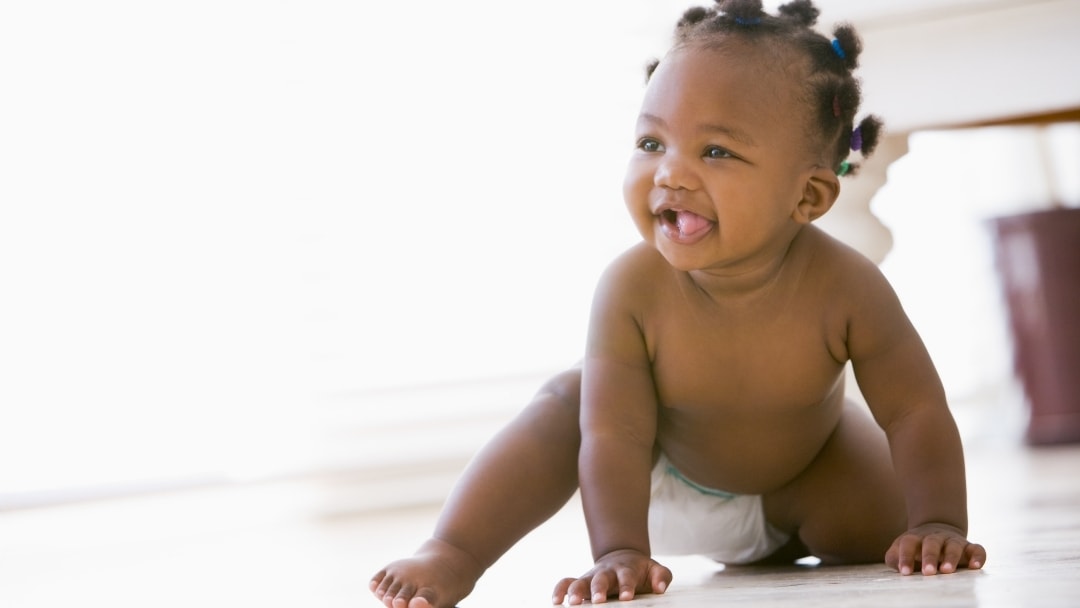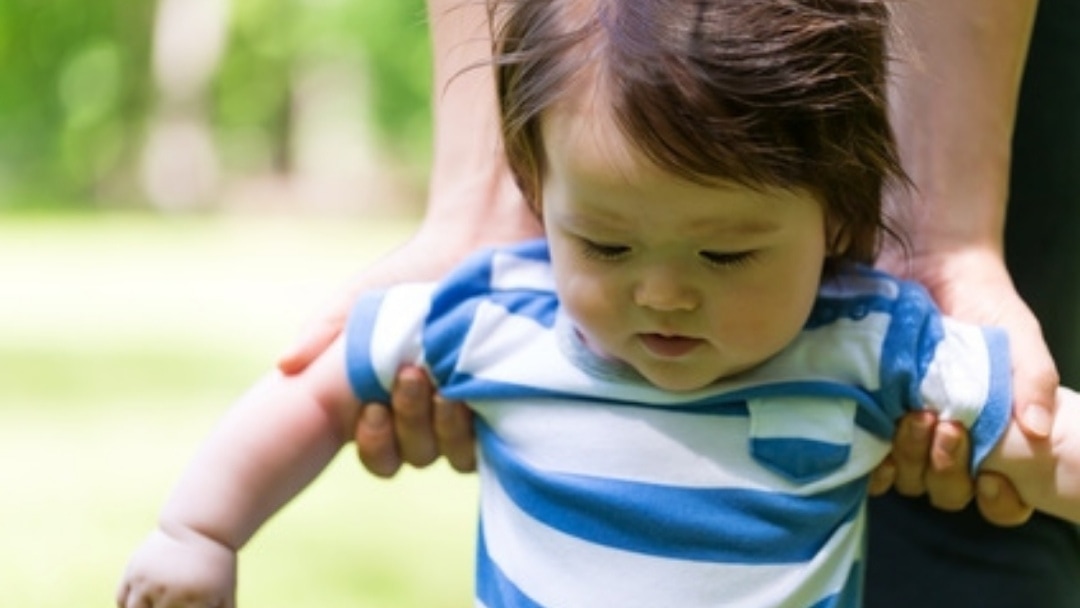Sally Goddard Blythe explains the relationship between retained reflexes and developmental delays, which are often seen in children with autism, ADHD, Sensory Processing Disorder, and learning disabilities in this post.
Ever wonder why babies startle, grasp your finger or turn their heads toward an out-stretched arm? These behaviors are primitive reflexes that emerge as early as nine weeks in utero, and are fully present at birth. Primitive reflexes are automatic movements, executed without thinking. They assist in the birthing process, are essential for the infant’s survival in the first months of life, and provide training for many later skills.
Primitive reflexes are considered “aberrant,” however, if they remain active beyond age 6-12 months. They should be inhibited by the brain, allowing more sophisticated neural structures to develop. The continued presence of any of twelve primitive and postural reflexes is a sign of central nervous system (CNS) immaturity, which can have a profound impact upon a child’s development, learning and behavior.
What Do Retained Reflexes Have to Do with Learning and Behavior?
Motor control lays the foundation for learning and self-control. We acquire new skills by moving our bodies intentionally. To track visually left to right, to shape consonants in the mouth, and to form letters, we need to have intentional control of the muscles involved. When those muscles obey an unconscious reflex instead of responding to our intention, then the activity is confusing and cannot become an automatic learned skill.
Academic learning depends upon the automation of basic skills at a physical level. If a child fails to develop this automatic motor control, a teacher might observe such symptoms as reversals in reading and writing, mis-articulations, poor impulse control, difficulty reading body language, or unsatisfactory peer relationships, despite good intelligence. Change is unlikely unless the underlying neuro-developmental problem is addressed.
What Are Some of the Reflexes?
Three retained reflexes are so important in children with developmental problems that they deserve special attention. These are the Moro, palmar and asymmetrical tonic neck reflex (ATNR). These and others, their development and long-term effects are elaborated upon in my book, A Teacher’s Window Into The Child’s Mind.
Moro Reflex
The Moro reflex, the earliest to emerge, forms a cornerstone for life. Characterized by rapid inhalation and sudden movement of the arms upward, followed by a cry, it is an involuntary reaction to threat. Normally inhibited by four months, it can be triggered in later life in situations of extreme danger.
Long-term effects of a retained Moro are vestibular-related problems such as motion sickness, poor balance and coordination, oculomotor and visual perceptual problems and hypersensitivity to light and sound. Psychological symptoms include free-floating anxiety, mood swings and insecurity.
Palmar Reflex
The palmar reflex, emerging at 11 weeks in utero, is characterized by an involuntary grasp with light touch to the palm. This primitive reflex goes back to past evolution, when neonates clung to their mothers for safety. Normally the reflex fades as refined finger control and the ability to release develop. It is replaced by the pincer grip at age 36 weeks.
Some long-term effects of a retained palmar reflex are poor manual dexterity and handwriting, with lack of independent thumb and finger movements, no pincer grip, and hypersensitivity of the palm to tactile stimulation.
Asymmetrical Tonic Neck Reflex (ATNR)
The ATNR links turning of the baby’s head to one side with extension of the arm and leg on that side and flexion of the limbs on the opposite side. In utero the ATNR provides continuous motion, stimulating balance mechanisms and increasing neural connections.
It ensures a free passage of air when the neonate is prone, increases extensor muscle tone, and forms the basis for later reaching movements. After age six months, a persistent ATNR interferes with balance, crossing the midline, crawling, eye tracking, and visual- and fine-motor control.
How Are Aberrant Reflexes Diagnosed and Treated?
The Institute for Neuro-Physiological Psychology (INPP), in Chester, UK has devised a protocol of standard neurological tests to demonstrate the presence or absence of primitive reflexes. On the basis of the child’s reflex profile, the Institute prescribes a daily 5-10 minute home program of reflex stimulation or inhibition exercises, spanning a period of 9 to 12 months.
Fortunately, research shows that the “wiring” of the CNS is changeable, particularly in the early years. Follow-up studies confirm progress in all areas of physical, academic and behavioral development.
Sally Goddard Blythe is a researcher and therapist at The Institute for Neuro-Physiological Psychology (INPP) in Chester, UK.
Editor’s note: Interventions such as occupational therapy, vision therapy and Brain Gym can help to inhibit aberrant reflexes.
Still Looking for Answers?
Visit the Epidemic Answers Practitioner Directory to find a practitioner near you.
Join us inside our online membership community for parents, Healing Together, where you’ll find even more healing resources, expert guidance, and a community to support you every step of your child’s healing journey.
Sources & References
Amos, P. Rhythm and timing in autism: learning to dance. Front Integr Neurosci. 2013 Apr 19;7:27.
Barnhill, E. Neural connectivity, music, and movement: a response to Pat Amos. Front Integr Neurosci. 2013 Apr 24;7:29.
Cho, H., et al. Effects of Action Observation Training with Auditory Stimulation on Static and Dynamic Balance in Chronic Stroke Patients. J Stroke Cerebrovasc Dis. 2020 May;29(5):104775.
Grigg, T.M., et al. Retained primitive reflexes: Perceptions of parents who have used Rhythmic Movement Training with their children. J Child Health Care. 2018 Sep;22(3):406-418.
Grzywniak, C. Integration exercise programme for children with learning difficulties who have preserved vestigial primitive reflexes. Acta Neuropsychologica. 2017;15(3).
Hardy, M.W., et al. Rhythm, movement, and autism: using rhythmic rehabilitation research as a model for autism. Front Integr Neurosci. 2013 Mar 28;7:19.
Herbert, J., et al. Crawling is associated with more flexible memory retrieval by 9-month-old infants. Dev Sci. 2007 Mar;10(2):183-9.
Hong, H.J., et al. Effect of Rhythmic Movement Program to Improve Walking Ability for Elderly Patients with Stroke. Indian Journal of Science and Technology. 2016 Jul;9(26).
Iverson, J.M. Developing language in a developing body: the relationship between motor development and language development. J Child Lang. 2010 Mar;37(2):229-61.
Jordan-Black, J. The effects of the Primary Movement programme on the academic performance of children attending ordinary primary school. Journal of Research in Special Educational Needs. 2005 Nov;5(3):101 – 111.
Kadivar, Z., et al. Effect of step training and rhythmic auditory stimulation on functional performance in Parkinson patients. Neurorehabil Neural Repair. 2011 Sep;25(7):626-35.
Ladányi, K. et al. Is atypical rhythm a risk factor for developmental speech and language disorders? Wiley Interdiscip Rev Cogn Sci. 2020 Sep;11(5):e1528.
Lakatos, P., et al. A New Unifying Account of the Roles of Neuronal Entrainment. Curr Biol. 2019 Sep 23;29(18):R890-R905.
McWhirter, K., et al. The association between learning disorders, motor function, and primitive reflexes in pre-school children: A systematic review. J Child Health Care. 2022 Jul 13;13674935221114187.
Melillo, R., et al. Persistent Childhood Primitive Reflex Reduction Effects on Cognitive, Sensorimotor, and Academic Performance in ADHD. Front Public Health. 2020 Nov 17;8:431835.
Suh, J.H., et al. Effect of rhythmic auditory stimulation on gait and balance in hemiplegic stroke patients. NeuroRehabilitation. 2014;34(1):193-9.
Van Hirtum, T., et al. Is atypical rhythm a riskfactor for developmental speech and language disorders? J Assoc Res Otolaryngol. 2021 Jul;22(4):465-480.
Winkler, I., et al. Newborn infants detect the beat in music. Proc Natl Acad Sci U S A. 2009 Feb 17;106(7):2468-71.
Zaigham, M., et al. Prelabour caesarean section and neurodevelopmental outcome at 4 and 12 months of age: an observational study. BMC Pregnancy and Childbirth. 2020 (20)564.
Zentner, M., et al. Rhythmic engagement with music in infancy. Proc Natl Acad Sci U S A. 2010 Mar 30;107(13):5768-73.
Resources
Books
Blomberg MD, Harald and Dempsey, Moira. Movements That Heal, Rhythmic Movement Training and Primitive Reflex Integration. Independenly published, 2011.
Brandes, Bonnie. The Symphony of Reflexes: Interventions for Human Development, Autism, ADHD, CP, and Other Neurological Disorders. CreateSpace Independent Publishing Platform, 2016.
Goddard Blythe, Sally. The Well Balanced Child: Movement and Early Learning. Hawthorn Press, 2005.
Goddard, Sally. Reflexes, Learning and Behavior, A Window Into the Child’s Mind. Fern Ridge Press, 2005.
Websites
Balance Brain Achievement Centers
Institute for Neuro-Physiological Psychology
My Child Will Thrive: Primitive Reflexes Cheat Sheet




